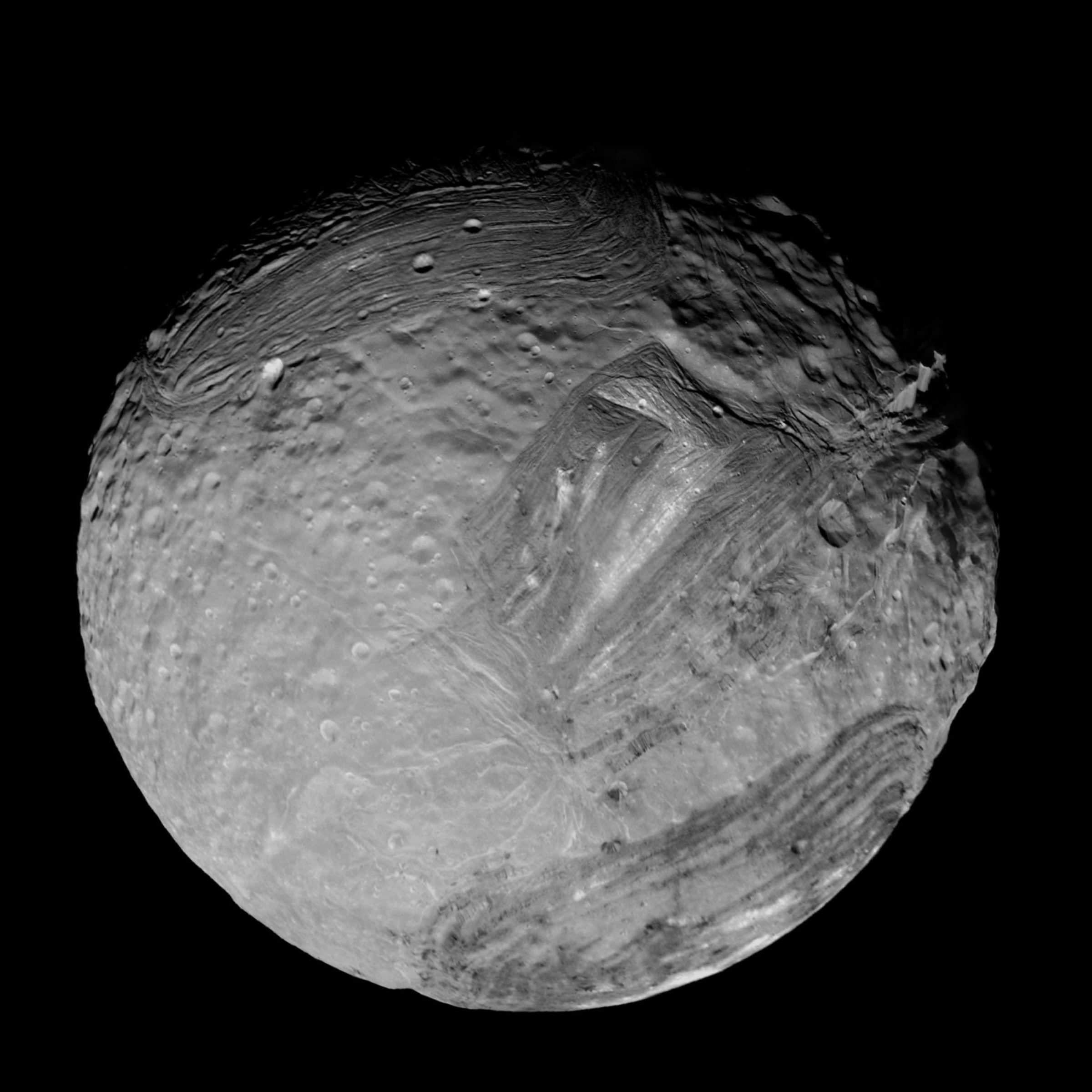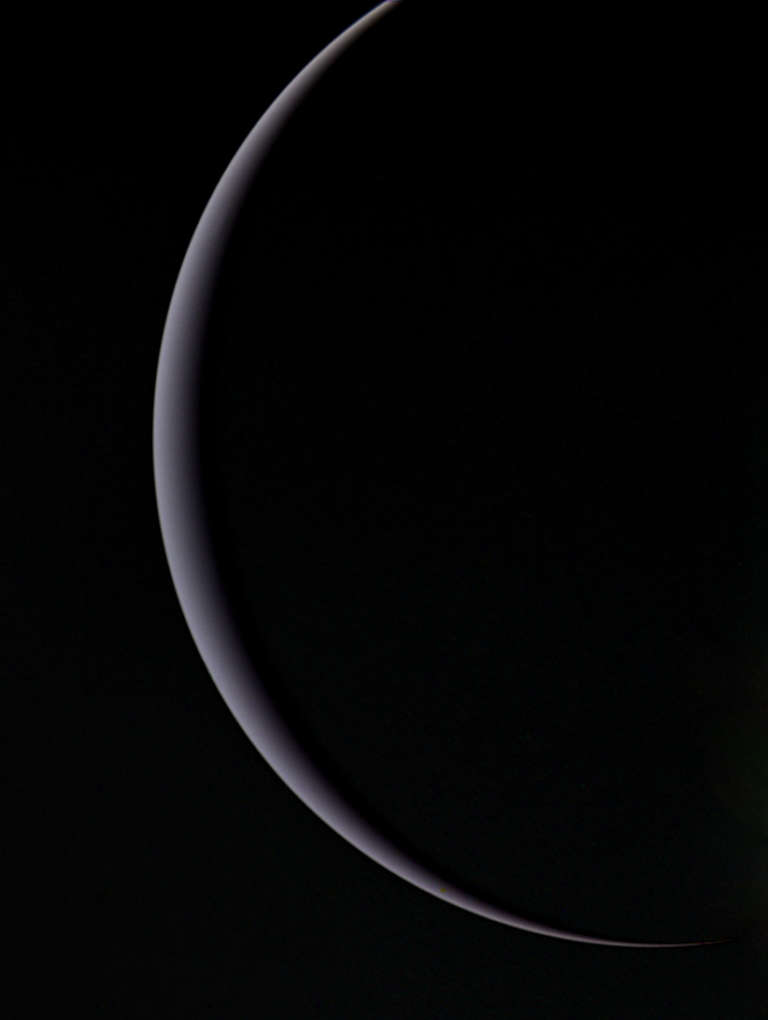Emily Lakdawalla • Jan 28, 2011
Uranus and Challenger
In the past week there have been 25th anniversaries of two events in 1986, one great, one terrible: the closest approach of Voyager 2 to Uranus on January 24, and the explosion of the space shuttle Challenger upon liftoff on January 28. It was just before my 11th birthday, and I was in the 6th grade. I don't recall whether I saw Uranus images in the news at the time. I of course saw them later, in my science books and on public television shows, and I've always been sort of fascinated by the least appreciated of the giant planets, and by how little we really got to see of its family of moons.
I think I was in Texas History class when a 7th grader -- who'd been watching the launch live with his class in an adjacent classroom -- burst into our room to announce "the shuttle just blew up!" We all trooped in to the 7th graders' classroom and watched the aftermath for what felt like forever before finally splitting off into our separate classes again; I don't think much more classroom instruction was accomplished that day.
I don't think I had heard of Christa McAuliffe before she died in that accident (or if I had, I hadn't been paying attention). But I learned about her that day of course, and I do remember wondering what exactly it was she had died for, and not really understanding what it was the Shuttle was supposed to be doing, or what she was doing on it. I think that the juxtaposition of Voyager's great journey of discovery and the Challenger disaster is one reason for my love for robotic exploration.
There were remembrances of Challenger all over the Internet today, including lots on Twitter. One conversation in particular grabbed my attention, between Luke Dones and another scientist. Luke is a rings guy on the Cassini imaging team; it became clear from his Tweets that he'd actually been at JPL watching Uranus images come down from Voyager 2 when Challenger happened, so I asked him to tell me about what both were like.

I had started working on Voyager images on Saturn's rings in the summer of '84. I was a student at Berkeley, but moved down to Mountain View to work with Jeff Cuzzi at Ames. He invited me to come help at the Uranus encounter. I flew down from the Bay Area with Mark Showalter, who in January '86 was in his first month as Jeff's postdoc. (I was a grad student until a year later.) I remember being in awe of the Voyager scientists like Torrence Johnson, Larry Soderblom, and Gene Shoemaker. My job was to do some quick photometry on the Uranian rings. Overall, images from the Uranus encounter were probably the least striking of any of the Voyager flybys, but everyone was excited about Miranda. Gene Shoemaker had estimated in the 30-day reports in Science that some of the satellites of Saturn had probably been disrupted and reassembled repeatedly, and Miranda looked that way.
My strongest memory about the rings from that encounter was when we first saw the famous high-phase image showing all the structure that wasn't visible at lower phase angles. I think that was Sunday, Jan. 26. Jeff Cuzzi was doing an interview with Al Hibbs when the image came down. Al asked him about it, and Jeff tried to blurt something innocuous, because the scientists weren't supposed to do instant analysis on TV. When the interview was over, Jeff ran out of there as fast as he could and about 10 of us crowded into a tiny little room. The monitors we had to look at images in those rooms had something like a 10- or 12-inch screen. I think Mark Showalter put a sheet of paper diagonally across the screen as a template and was the first to figure out that the brightest feature wasn't the epsilon ring, but a previously unknown ring.
As far as Challenger, I knew there would be a teacher in space (my wife was getting her teaching degree at the time), but the Challenger launch had been delayed repeatedly, and I'm not sure I knew it was going to launch on January 28. Mark and I were flying back to the Bay Area that afternoon, and of course we'd been busy with the encounter. The Shuttle program wasn't something I paid a lot of attention to. I was lucky enough to grow up during NASA's glory years (I was born 10 days after the Sputnik launch), and after the Moon landings, Apollo-Soyuz, and Skylab, the Space Shuttle didn't seem that great. I do remember excitedly waiting to see the first Shuttle launch on TV in 1981, and it being delayed enough that I didn't see it live.
Anyway, on January 28, 1986, I think someone told me just a few minutes before the launch that it was happening, so we switched the crummy little monitor I mentioned above to watch. The thing I didn't realize at first was that the gain was turned up really high so we could look for faint rings. When the launch happened, the picture was pretty close to being saturated. I think just Al Cook, Andy Ingersoll, and I were in the room. (There were 10 (?) little rooms with those monitors, so there were probably a few people in each one.) Once it became clear from the CAPCOM that something had gone terribly wrong, Andy turned down the gain and then we could see what had happened. Of course, we were all in a state of shock. I remembered the Apollo 1 fire, but NASA had never lost astronauts during a spaceflight, so it was hard to grasp. It obviously wasn't on the scale of 9/11, but as in that case, the Challenger explosion was something that was just outside of everyone's experience. There was still a fair amount of press at JPL, but the scientists didn't know more than anyone else what had happened. I'm sorry, I don't really remember anything else that day, except no one knowing what to say and flying back to the Bay Area.
Thanks to Luke for sharing his recollections of those days. Check out the mission status bulletins from Voyager 2's Uranus encounter to remind yourself of that time.

Let’s Go Beyond The Horizon
Every success in space exploration is the result of the community of space enthusiasts, like you, who believe it is important. You can help usher in the next great era of space exploration with your gift today.
Donate Today

 Explore Worlds
Explore Worlds Find Life
Find Life Defend Earth
Defend Earth

